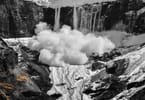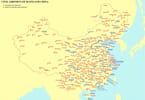Much of the central and eastern United States can expect mild weather often from December into January due to El Niño.
El Niño occurs when tropical Pacific waters are warmer than normal, and the pattern can last several months to a couple of years. The warm waters can impact the weather patterns around much of the globe.
While the pattern may not be good news for cold weather enthusiasts, it will translate to savings on heating for at least part of the winter.
According to AccuWeather Chief Long Range Meteorologist Paul Pastelok, an ongoing and strengthening El Niño may succeed in keeping arctic air out of much of the United States well into the winter.
“We see impressive signals that the overall mild pattern that got rolling in the Central and Eastern states during October and November will hold through December and into January,” Pastelok said.
“El Niño is contributing to a strong belt of westerly winds across Canada that will help keep the polar vortex strong but locked up near the Arctic Circle,” Pastelok said.
This does not necessarily mean that every day will be mild and free of snow in the central and eastern U.S., but rather cold and snowy days will be infrequent.
As temperatures naturally trend downward into January, some storms may still produce substantial snow, especially in the northern tier, in the Appalachians and the Central states. However, the snow may not lay around very long as temperatures may not remain cold enough.
This year’s El Niño is already considered to be strong and may continue to strengthen over the next couple of months. In recent years that had a strong El Niño, temperatures averaged much above normal in most of the Central and Eastern states.
For example, the El Niño of 1997-98 brought an average temperature for December through February of 7.2 degrees Fahrenheit above normal in Minneapolis.
The mild conditions produced during a strong El Niño can limit the amount of snow that falls from storms along the Atlantic Seaboard.
During the strong El Niño of 1972-73, Philadelphia did not receive measurable snow during the entire winter. Measurable snow is 0.1 of an inch or more. During the same winter, New York City also experienced its least snowiest winter with 2.8 inches of snow. Boston had its third least snowiest winter, with only 10.3 inches of snow received. Records for these cities date back to the mid-1800s.
While there are a number of factors that determine the weather pattern for the winter, a major player is associated with the strength of the El Niño.
For instance, during a weak or weakening El Niño, fluctuating steering winds across the U.S. and Canada may allow the polar vortex to shift position and send frigid air well to the south.
There is some lag to the impact of a strong El Niño.
“When El Niño starts to weaken, we do not always get an immediate change in the weather pattern,” Pastelok said. “We believe that once the current El Niño peaks, there may be enough of a lag to carry the warmth through much of the winter.”
WHAT TO TAKE AWAY FROM THIS ARTICLE:
- While there are a number of factors that determine the weather pattern for the winter, a major player is associated with the strength of the El Niño.
- “We believe that once the current El Niño peaks, there may be enough of a lag to carry the warmth through much of the winter.
- According to AccuWeather Chief Long Range Meteorologist Paul Pastelok, an ongoing and strengthening El Niño may succeed in keeping arctic air out of much of the United States well into the winter.






















